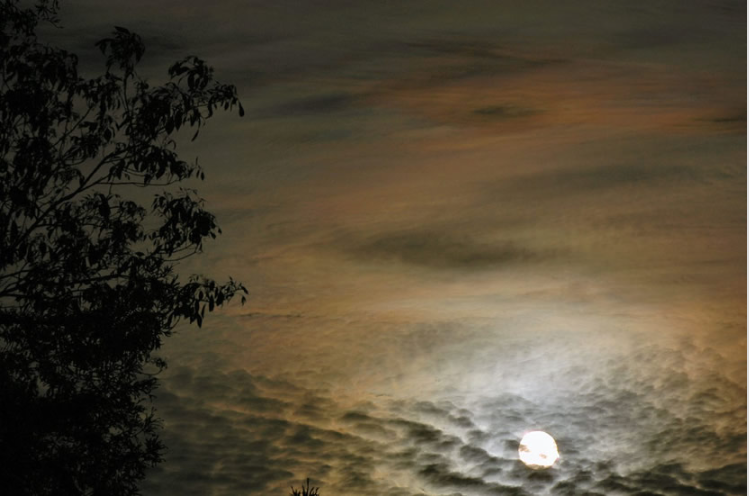Low Sun Iridescence, California
Low Sun Iridescence: A Spectacular Display in California
Have you ever witnessed a mesmerizing display of colors in the sky during the low sun hours? This phenomenon, known as low sun iridescence, is a captivating atmospheric optics event that can be observed in various locations around the world, including California. In this article, we will delve into the intricacies of low sun iridescence and explore its causes and visual effects.
The Enchanting Display
One such instance of low sun iridescence was beautifully captured by photographer Dave Rout in Redwood City, California, in May 2006. The photograph reveals a sky adorned with delicate and intricate hues, creating a stunning visual spectacle. The vibrant colors seem to dance across the sky, captivating the observer's gaze and instilling a sense of awe and wonder.
The Science Behind Low Sun Iridescence
Low sun iridescence occurs when sunlight interacts with tiny water droplets or ice crystals suspended in the atmosphere. As the sun nears the horizon during sunrise or sunset, its light must pass through a thicker layer of the Earth's atmosphere. This increased path length causes the light to scatter and interact with the suspended particles, leading to the formation of iridescent colors.
Optical Phenomena at Play
Several optical phenomena contribute to the creation of low sun iridescence. The most prominent one is diffraction, which occurs when light waves bend or spread out as they encounter obstacles or pass through narrow gaps. In this case, the tiny droplets or ice crystals act as diffracting elements, causing the sunlight to diffract and create the vibrant colors observed in the sky.
Another crucial factor is interference, which arises when light waves superpose and either reinforce or cancel each other out. As the sunlight passes through the suspended particles, interference patterns are formed, resulting in the distinct bands of colors seen during low sun iridescence.
The Role of Droplet Size
The size of the water droplets or ice crystals plays a crucial role in determining the appearance of low sun iridescence. Smaller particles tend to produce more vivid and intense colors, while larger particles may result in broader bands of color with less intensity. The precise size distribution of the suspended particles determines the overall visual effect observed in the sky.
Environmental Conditions and Viewing Opportunities
To witness low sun iridescence, specific environmental conditions must align. Firstly, there needs to be a sufficient concentration of suspended particles in the atmosphere, such as mist, fog, or high-altitude clouds. Additionally, the angle at which sunlight interacts with these particles must be low, typically during sunrise or sunset.
California's diverse climate and geography provide ample opportunities for experiencing low sun iridescence. Coastal regions often experience marine layers and fog, creating an ideal setting for the formation of iridescent skies. Additionally, mountainous areas with high-altitude clouds can also offer breathtaking displays of low sun iridescence.
Capturing the Beauty
Photographing low sun iridescence can be a rewarding experience for photographers and enthusiasts alike. To capture the intricate colors and delicate patterns, it is essential to use a camera with good dynamic range and adjust the exposure settings accordingly. Experimenting with different angles and compositions can result in truly stunning photographs that showcase the ethereal beauty of low sun iridescence.
Appreciating Nature's Splendor
Low sun iridescence serves as a reminder of the mesmerizing wonders that can occur in our atmosphere. Observing this phenomenon allows us to appreciate the complexity and beauty of nature's optical intricacies. Whether you witness it in California or any other part of the world, low sun iridescence offers a fleeting yet enchanting display that reminds us of the awe-inspiring phenomena that surround us.
Conclusion
Low sun iridescence is a captivating atmospheric optics event that can be observed in various locations, including California. Its formation relies on the interaction between sunlight and suspended particles in the atmosphere, resulting in vibrant and mesmerizing colors. Understanding the science behind low sun iridescence and appreciating its visual splendor can enrich our connection with the natural world and deepen our appreciation for the wonders of the sky. So, keep your eyes peeled during the low sun hours, and you might just witness this enchanting phenomenon unfold before your eyes.

Low sun iridescence
Dave Rout captured this intricate and subtle sky at Redwood City, California in May '06.
©Dave Rout, shown with permission.
Note: this article has been automatically converted from the old site and may not appear as intended. You can find the original article here.
Reference Atmospheric Optics
If you use any of the definitions, information, or data presented on Atmospheric Optics, please copy the link or reference below to properly credit us as the reference source. Thank you!
-
<a href="https://atoptics.co.uk/blog/low-sun-iridescence-california/">Low Sun Iridescence, California</a>
-
"Low Sun Iridescence, California". Atmospheric Optics. Accessed on April 19, 2024. https://atoptics.co.uk/blog/low-sun-iridescence-california/.
-
"Low Sun Iridescence, California". Atmospheric Optics, https://atoptics.co.uk/blog/low-sun-iridescence-california/. Accessed 19 April, 2024
-
Low Sun Iridescence, California. Atmospheric Optics. Retrieved from https://atoptics.co.uk/blog/low-sun-iridescence-california/.